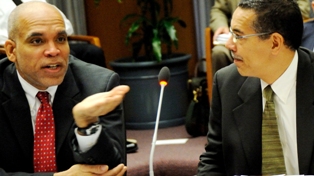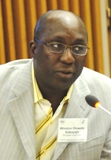Fogarty hosts 2008 summit on sub-Saharan Africa
November / December, 2008 | Volume 7, Issue 6

Acting NIH Director Dr. Raynard Kington, left, opens
the Fogarty-sponsored conference on how to
strengthen research in sub-Saharan Africa. Fogarty
Deputy Director, Dr. Michael Johnson is at right.
Converting a brain drain into a "brain gain" occupied science leaders from sub-Saharan nations, Africans who now work in U.S. labs and NIH leadership at a recent Fogarty-sponsored summit on African research.
The conference on campus drew more than 100 people, including representatives from 25 of the 27 institutes and centers and came two weeks before the worldwide health research gathering in Bamako, Mali. In Bamako, health ministers urged countries to spend at least 2 percent of their health budgets on research and charities 5 percent.
During a day and a half of freewheeling discussion, conference cohost Dr. Charles N. Rotimi, the Nigerian-born-and-educated director of the NIH Center for Research on Genomics and Global Health, noted the high level of research that is already going on in the region and asked the central question: "How do we change from a brain drain to a brain gain for the region."
The imperative to strengthen the scientific research enterprise stems from sub-Saharan Africa's high level of disease, low level of trained medical professionals and actual decline in life expectancy in recent years, said Dr. Roderic Pettigrew, director of the National Institute of Biomedical Image and Bioengineering.
The challenge, he said, is "the retention of trained medical professionals... to induce them to return to their home countries, where the need is even greater."
NIH has had a long-standing relationship with African researchers both as a result of extramural grant funding as well as its intramural program, said Fogarty Director Dr. Roger I. Glass. The goal of the meeting was to better understand specific actions of NIH could take to bolster the scientific research enterprise in the poorest countries of the continent, including making use of the expensive scientists.
"As development agencies and private foundations recognize the relationship between health and development, we must establish more systematic working arrangements between academic health centers and these organizations to more fully integrate biomedical and behavioral research into health and assistance programs," said Dr. Raynard Kington at his first major appearance since becoming Acting Director of the NIH.
"This can only happen if we create more opportunities for scientist-to-scientist interactions, facilitate institutional capacity building and gather sufficient knowledge of one another to take hold of every available scientific opportunity," he said in his keynote address.
The shortage of mentors and innovative technology outside their home institutions and countries is a powerful lure for the best young African scientists to pursue their careers in America or high-income countries, especially when African governments may not put public health or scientific research high on national agendas, participants said.
"If you invest in people in Africa and you invest in ideas in Africa and if you engage the governments to provide the mechanisms to sustain these efforts, the brain drain would be resolved," argued Dr. George Mensah, a Nigerian-trained cardiologist with the CDC, argued. "But if you invest in the diaspora, that would worsen the brain drain and make even more people come to the diaspora."
It is up to science professionals themselves to take the lead in getting NIH, European Union and other support, said Dr. Onesmo ole-MoiYoi, a scientist and administrator with the International Centre of Insect Physiology and Ecology in Kenya.
He called on diaspora scientists to visit sub-Saharan Africa more frequently, collaborate with its scientists, take sabbaticals to the region and exchange staff. He urged African scientists to convince governments of Africa to accord research a high priority.
Dr. Clement Adebamowo, a Fogarty bioethics grantee and chair of the Nigerian National Health Research Ethics Committee, noted that the diversity of African populations create rich research opportunities, citing as an example his own country, with more than 250 different ethnic groups. Diverse cultural attitudes and dietary habits provide the base for studies on genetic and environmental factors that cause disease, he said.
Dr. Winston "Wole" Soboyejo runs the U.S./Africa Materials Institute at Princeton, a "virtual" organization of faculty, scientists and students from the United States and Africa.
He suggested that since pharmaceutical companies already are in other countries doing clinical trials, they might have a stake, along with NIH and other government agencies, in training a new generation of scientists relying on long-distance learning and ethnically sound clinical operations.
Under his mentorship, 16 international researchers visit America to work with collaborators for nine weeks to six months, return to their home countries to continue their work, and while many return to the United States to engage in a specific project, their overall research agenda must take a systems-based approach in one of four areas the institute focuses on.

Dr. Winston Soboyejo,
suggested establishing
"virtual" centers of
excellence.
One example of how NIH collaboration with researchers in West Africa can help U.S. citizens is Rotimi's program of studying diabetes, which is far more prevalent in African-Americans than in their ancestors due, apparently, to a combination of genetic and environmental components.
There was general agreement that research opportunities should be sought not just in infectious diseases but in diabetes, cardiovascular disease, cancer and other chronic conditions that reduce lifespan in low- and middle-income countries.
Much of what Fogarty has done in building North-South partnerships has been founded on a few basic principles, Dr. Thomas Quinn of the intramural research division of NIAID explained.
They are: The goals must be defined and specific; the relationship must be based on trust, ethics, respect and understanding of cultural differences; research and training should be based on shared interests and problems; and the collaboration must be advantageous to both parties, taking up to two decades to fully work.
More Information
To view Adobe PDF files,
download current, free accessible plug-ins from Adobe's website.